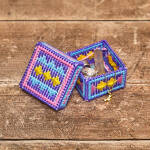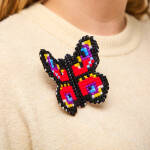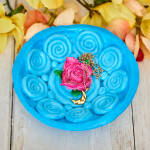Skill Level
Beginner
Time to Make
1 hour + 24-48 hours drying time for paint
Adult Supervision Needed
Yes
How to Make
Before you start, cover your work area with newspaper. Prepare an area where the canvas can be left to dry as the paint will drip down the sides. Have some paper towel handy for any spills, wear old clothes and cover the floor if necessary.
- Pour 1cm of white acrylic paint into a paper cup, add the same amount of PVA glue then stir well so the paint and PVA are smoothly mixed together. The consistency needs to be similar to single cream and pourable, but not too runny. If the mixture looks too thick, add a very small amount of water then mix again. Add about 10 drops of oil to the mixture and stir it in.
- Make another mix in a cup in the same way using equal amounts of a coloured acrylic paint with PVA then add the oil. If you are using more colours, make more mixes in the same way, with each colour in a separate cup.
- Pour about a tablespoon of the white mix into a new cup, add the same amount of the colour mix on top then add more white. Don’t stir or mix the colours. If you are using several colours, pour a little of each mix into the cup, adding some white in between.
- Place a painting canvas over the top of the cup, with the canvas side facing down. Place your hand flat over the back of the canvas then flip it over, holding onto the cup, then place the canvas onto your work surface. Leave the cup upside down for a few seconds then lift it up, allowing the paint mixture to spread over the canvas. Leave the paint to spread for about a minute then gently tip it from side to side so the paint covers the surface.
- Try tipping the canvas to swirl the paint in different directions, or drip the leftover paint from the cup over the top of the paint surface to make patterns. As the paint spreads, the oil should create small bubble patterns like cells.
- Tip the canvas so the paint drips down the sides, if necessary use a brush to push the paint into any areas still uncovered. Leave to dry.



Top Tip
There is no precise method for making patterns with acrylic paint. Allow time to experiment to find out which effects you prefer, and whether to add oil or not. Mixing oil with the paint creates small bubbles and cells in the paint surface as it spreads, but you can still create interesting patterns without it. The oil can be silicone based, for example, a ‘3 in 1’ general purpose oil, or try a cheap hair oil. This technique can also be used to add a pattern onto a box. Drip the paint mixture from a cup onto the lid then cover the sides.
Tagged with:
Paint Pouring












